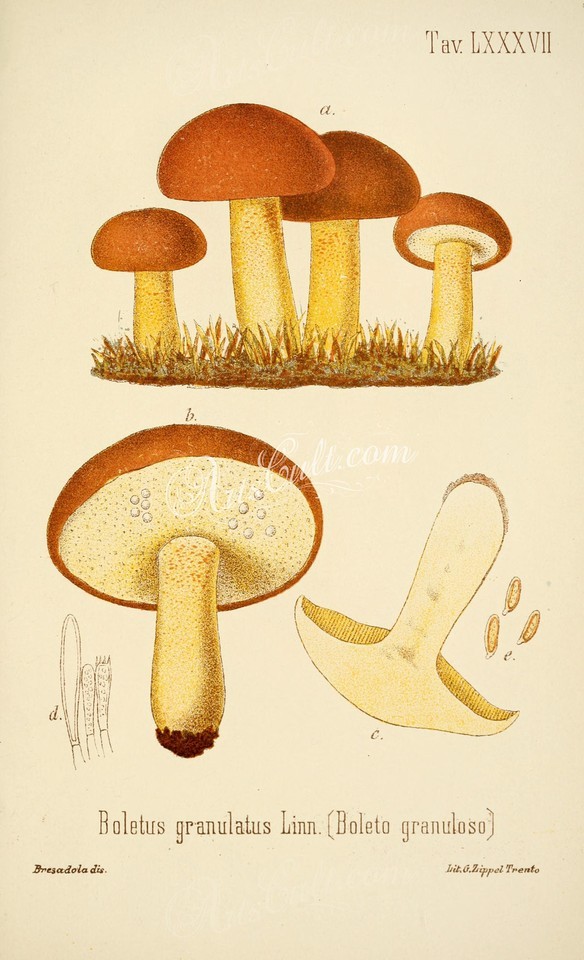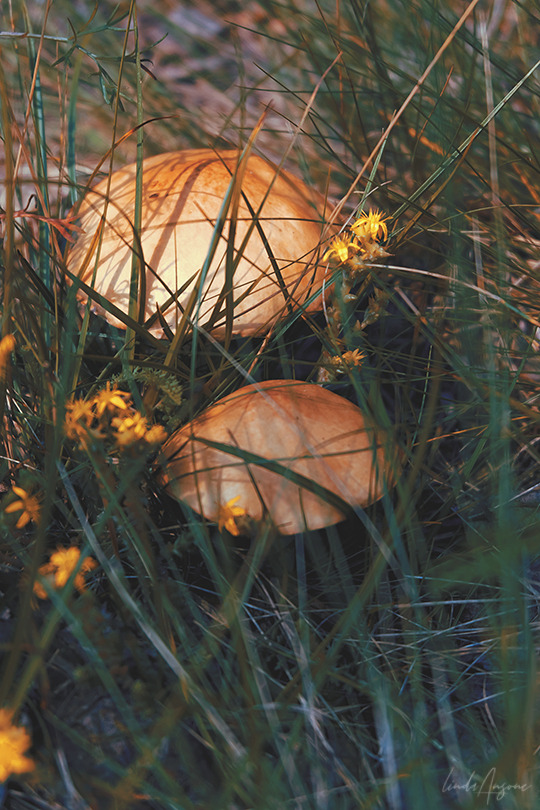#Boletus granulatus
Note
Are there particular species of trees edible mushrooms like growing near? For example, the way truffles are generally found under oak trees? (I hope I got that right!)
Yes, you are right. A symbiotic association between a fungus and a plant is called mycorrhiza. Different mushroom species will choose different trees, however, the type of soil plays a big part, too, and not every species is super picky. Some will grow under/on both deciduous and coniferous trees.
Examples:
Boletus edulis - spruce.
Boletus pinophilus - pine.
Boletus reticulatus (syn. B. aestivalis) - oak trees.
Boletus projectellus (syn. Boletellus projectellus) / Aureoboletus projectellus) - pine.
Boletus betulicola/ B.edulis var. betulicola - birch trees.
Leccinum albostipitatum - aspen.
Leccinum aurantiacum - aspen.
Leccinum versipelle (syn. L. testaceoscabrum) - birches and spruce.
Leccinum duriusculum - birches and aspen.
Leccinum vulpinum - pine.
Leccinum melaneum (syn. L. roseofractum) - birch trees.
Leccinum variicolor - birch trees.
Leccinum niveum (syn. L.holopus) - birch trees.
Leccinum crocipodium (syn. Leccinellum crocipodium) - oak trees.
Leccinum scabrum f.oxydabile - birch trees.
Leccinum aurantiacum f.quercinum - oak trees.
Suillus granulatus - pines.
Suillus luteus - pines.
Suillus flavidus - pines.
Suillus grevillei - larches.
Suillus viscidus (syn. S.aeruginascens) - larches.
Suillus cavipes (syn. Boletinus cavipes) - larches.
Suillus variegatus - pines.
Suillus bovinus - pines.
Lactarius deliciosus - pines.
Lactarius deterrimus - spruce.
Lactarius trivialis - spruce and birches.
Lactarius camphoratus - spruce.
Lactarius torminosus - spruce and birches.
Lactarius scrobiculatus - spruce.
Lactarius necator (syn. Lactarius turpis) - spruce and birches.
Lepista nuda - spruce and linden trees.
Tricholomopsis rutilans - pine and spruce.
Cantharellus cibarius - spruce, pine or birch
Sarcodon squamosus - pine trees.
Gyromitra esculenta - pine trees.
Coprinus comatus - grasslands.
64 notes
·
View notes
Text
#1851 - Suillus sp. - Slippery Jack

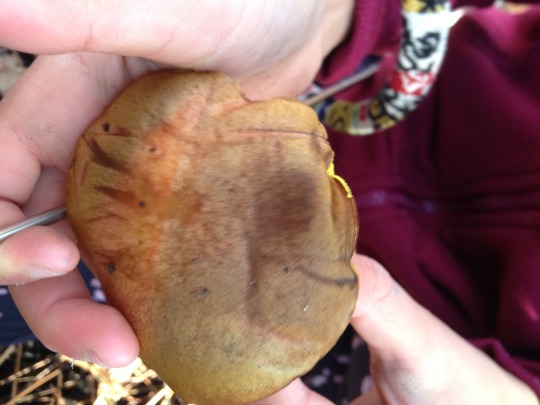
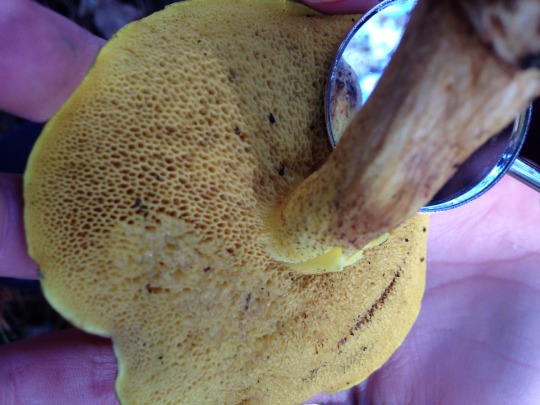
Also known as Butter Mushrooms, or in the case of the species formerly in the genus Fuscoboletinus, Larch Boletes. Other synonyms include Pinuzza, Boletus sect. Viscipellis, Euryporus, Cricunopus, Rostkovites, Peplopus, Ixocomus, Boletopsis, Solenia, Mariaella, and Gastrosuillus.
Suillus species, named after the Latin for pig, have greasy or slippery caps resembling a pig’s skin, and some species are highly desirable as food. However, the slimy cap can be a purgative, at least in some species.
Most grow in close mycorrhizal association with pines, and some have been spread around the world in pine plantations. That was the case here, with what is either Suillus granulatus (also known as the Weeping Bolete) and Suillus luteus, which I found growing in an abandoned pine plantation out in Jarrahdale SW of Perth. It’s probably granulatus, because it doesn’t have a ring around the stipe.
6 notes
·
View notes
Text
10 au 16 octobre 2022
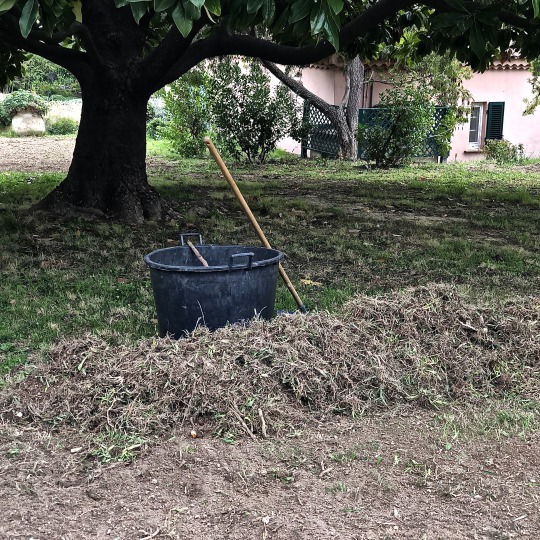

Another week of cutting back and autumn cleaning. I also started raking the meadow area, for a second time this year. I had to buy some knee pads due to all the cutting down of the Iris unguicularis and next the Hyparrhenia hirta and bulb planting.

Lucien arrived Tuesday and we went to his father’s house for dinner on Wednesday. I have to learn how to play belote. They love playing it and it needs four people to play in two teams.
My trottinette has another flat tire. I tried fixing it and the patch leaked anew. I will try replacing it with a solid tyre. It was very useful especially given the lack of petrol due to the strikes.
On Saturday night Lucien made a delicious chicken pie and a pear and chocolate cake for dessert. André joined us and we had a very nice evening.
We were up early Sunday morning because I ran the Courir pour une Fleur around the Cap d’Antibes. It was my first organised 10k. I ran it in just over 53 minutes and was the 483rd across the finish line. Not bad for never training.

Meanwhile in California, my cousin’s first grandchild (aka first cousin twice removed) was born, Parker Black.

Plant of the week
Suillaceae Suillus collinitus (Fr.) Kuntze
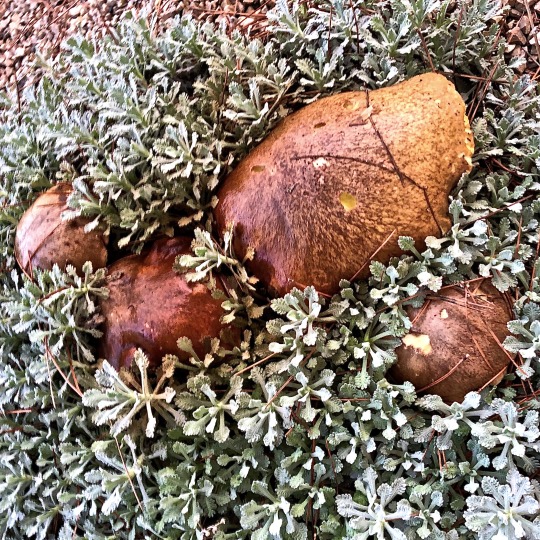
common name(s) - ringless yellow boletus; français : Bolet à mycélium rose
infraspecific(s) - Suillus collinitus var. aureus Huijsman; Suillus collinitus var. velatipes Contu, Lavorato & Simonini
synonym(s) - Boletus collinitus Fr.; Suillus fluryi Huijsman
conservation rating - none
native to - Europe
location - Domaine de l’Orangerie
description - reddish to chestnut-brown cap that reaches up to 110mm in diameter, and a yellow stem measuring up to 70mm tall by 10 to 20mm thick; on the underside of the cap are small angular pores, initially bright yellow before turning greenish-brown with age; a characteristic feature that helps to distinguish it from similar Suillus species, such as S. granulatus, is the pinkish mycelia at the base of the stem
spores - are seen ochre-brown in mass, but pale yellow when viewed with a light microscope; are fusiform (tapered at each end); basidia (spore-bearing cells of the hymenium) are four-spored
habitat - European pine forests, especially Pinus halepensis
pests - none found
disease - none found
hardiness - to -15ºC (H5)
soil - dry sandy soils
sun - dappled shade
propagation - does not typically produce fruit bodies in young plantations; fruiting behaviour may be attributed to the typically nutrient-poor xeric Mediterranean environment in combination with a lack of tree canopy; absence of above-ground indicators of fungal presence makes analysis of underground populations difficult
nomenclature - Suillaceae - Suillus - from the Latin noun sus, meaning pig, Suillus therefore means of pigs (swine) and is a reference to the greasy nature of the caps of nearly all fungi in this genus; collinitus - derived from Latin for smeared or greased, besmeared
NB - a mycorrhizal species, and forms associations with several species of pine, most notably Pinus halepensis the Aleppo pine, commonly used in reforestation schemes and soil conservation against erosion in the Mediterranean region, and S. collinitus is often used as a beneficial inoculant to help the young trees better survive in typically harsh soil conditions.
References :
First Nature [online] https://www.first-nature.com/fungi/suillus-collinitus.php [13 Nov 22]
Gledhill, David, (2008) “The Names of Plants”, fourth edition; Cambridge University Press; ISBN: 978-0-52168-553-5
Ultimate Mushroom [online] https://ultimate-mushroom.com/edible/261-suillus-collinitus.html [13 Nov 22]
Wikipedia [online] https://en.wikipedia.org/wiki/Suillus_collinitus [13 Nov 22]
0 notes
Photo

Boletus Granulatus y Lactarius Deliciosus. Cosas que uno encuentra buscando la pelota de golf 🍄⛳️🏌🏻🍄 (en Balneario Claromecó, Buenos Aires, Argentina) https://www.instagram.com/p/CQCYo6dpTXC/?utm_medium=tumblr
0 notes
Photo
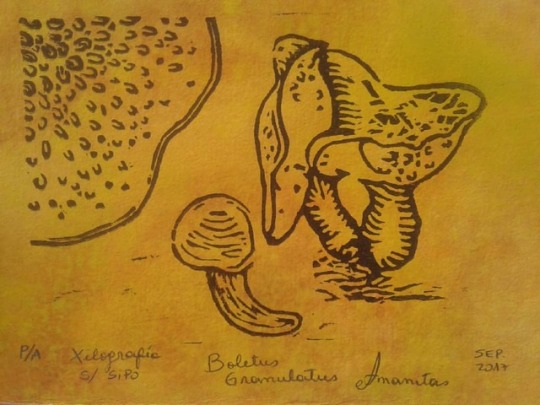
Xilografía en madera de Sipo, de seta Boletus Granulatus, sobre papel acuarelado #amanitas #xilografia #xilogravura #ilustração #ilustration #ilustracion #setas #papelacuarelado ##grafica #grabado #grabadoenmadera #boletusgranulatus #arteenconce #arte #art #arteenelbiobio #regiondelbiobiocunadelgrabado
#ilustração#boletusgranulatus#ilustracion#arte#art#grabadoenmadera#arteenelbiobio#arteenconce#grabado#grafica#regiondelbiobiocunadelgrabado#xilogravura#xilografia#papelacuarelado#amanitas#setas#ilustration
0 notes
Text
This autumn, I have been fortunate enough to spend quite a lot of time amongst my friends of the forest floor. As winter comes and the weather cools down, we are approaching the end of our time with these marvels of nature, so I figured now is a good time to make a post on the human world wide web regarding the findings that nature’s wood wide mycelial web has offered.
Before I get started on sharing my experiences from this year, let’s delve into the wondrous world of the humble mushroom.
When it comes to fungi, there is certainly more than meets the eye. The mushroom that we see growing above the soil is actually the reproductive structure or ‘fruiting body’ of the fungus. The purpose of the mushroom is to spread microscopic spores, which can measure as little as 4-5 microns, about the size of a human red blood cell. To put that into perspective, a human hair averages at about 75 microns across.
One could compare a mushroom to an apple on an apple tree, a tomato, a capsicum or even a pea pod as these are all the fruiting structures of their respective plants. But, as we all know, there is much more to a plant than just its reproductive structures, plants have chloroplasts containing chlorophyll which absorb light energy & they have a root system which uptakes moisture & nutrients. So, how can we compare a mushroom to a plant when they lack chloroplasts & a root system? This is where things start to get really interesting…
As I mentioned, the mushroom is the fruiting body of the fungus. Fungi have a microscopic thread-like structure called mycelium which travels underground in search of nutrients, moisture & hosts to ensure its continuing survival. Mycelium is made from a network of branching filaments known as hyphae, derived from the Greek ‘huphe’ meaning ‘web.’ In order for the fungus to make the most of the area it’s growing in & uptake nutrients with maximum efficiency, it begins at a central point (where the spore germinates) and sends out hypha in every direction, generally forming a rough circle. This is why we often see mushrooms (especially the common Marasmius oreades) growing in ‘fairy rings.’ It’s not magic, it’s simply a very efficient organism!
Fungi can be categorised by observing the substrate on which they grow.
Saprotrophic fungi are the great decomposers (‘sapro’ meaning ‘rotten material’ & ‘phyte’ meaning ‘plant.’) They release enzymes & acids which breakdown organic matter into smaller molecules so they they can absorb them. Having a healthy saprotrophic fungus in your compost is a huge asset & will definitely help speed things along. Saprotrophs are not limited to decaying wood but also animal carcasses, plants, leaf litter etc. Saprotrophic fungi such as Pleurotus ostreatus (oyster mushrooms) & Agaricus bisporus (button & portabello mushrooms) are ideal for cultivation as they don’t require a living host or symbiotic relationship. Which leads us to our next group…
Mycorrhizal The term ‘mycorrhizal’ literally means ‘fungus root.’ Mycorrhizal fungi have a symbiotic relationship with trees & other plants, an estimated 90-95% of plants form a mychorrhizal relationship with fungi. Endomycorrhizal fungi actually penetrate & weave their way through roots of plants where as Ectomycorrhizal fungi form a sheath on the outer layer of the plants roots. So, how exactly does this relationship benefit both the plant and the fungus?
As I mentioned earlier, plants have chloroplasts & fungi do not, this means that plants are a lot more effective at producing sugars. So, being the polite organisms that mycorrhizal fungi are, they want to form a relationship where they can gain sugars from the plants, but they won’t do so without offering something in exchange. Because mycorrhizae are significantly smaller than the roots of plants, they are able to access nutrients & moisture that plants could never dream of utilising. One of the main nutrients that fungi share with plants is phosphorus, which plays a role in photosynthesis, cell division & energy storage/transfer. This symbiotic relationship is extremely useful for both parties, there has been some interesting research in to the communication abilities of plants & fungus, it’s almost as if the plant places an order with the fungus to let them know what nutrients they should be searching for. There has also been some research into whether plants can use the underground mycelial web as a network of communication with one another, similar to our internet.
Wood wide web
Parasitic fungi find themselves a living host plant (or animal & occasionally another fungus. If we don’t have fungus to keep the fungus under control then we’ll be overwhelmed by fungus) to steal nutrients & moisture from. Parasitic fungi are the most selfish but are still a valuable part of a healthy ecosystem, within reason. They have been known to get slightly out of control. The largest fungus in the world is a parasitic Armillaria sp. aka ‘honey fungus’ which grows in the blue mountains of Oregon. The mycelial web of this fungus stretches to approximately 4km & is the largest known living organism on earth. The interesting thing about Armillaria is that some species are able to make a ‘switch’ to being Saprotrophic once they have exhausted the nutrients & eventually killed their live host.
By far, the most interesting parisitc fungi are those belonging to the Cordyceps genus. These fungi use living insects as hosts and have been labelled by some as ‘zombie fungus’ due to their ability to basically brainwash their host into assisting their with spreading their spores. BBC Cordyceps attack of the killer fungi
Endophytic fungi are absolutely tiny & make their home in the tissue of their host plants (leaves, stems, fruit.) Although endophytes, like most fungi, are not fully understood, They form a very interesting relationship where the plant remains healthy and even gains extra resistance from pathogens & attacks from parasitic fungi. These fungi have also been known to produce compounds which can make the host plant a less desirable meal for herbivores. More on endophytes
Now, before I get too carried away, let’s go back to the original point of this post.
Suillus luteus
Over the last few months, I have spent a decent amount of time foraging for mushrooms & other wild edibles, and have been fortunate enough to have the opportunity to share my knowledge with friends who have become interested in mushroom foraging. If you are new to mushroom foraging, it’s always a good idea to go out with someone who knows what they’re doing and to only pick mushrooms that you can identify 100% correctly, beyond a shadow of a doubt. Australian fungi are relativity unstudied in comparison to the fungi of Europe, so when searching for edible fungi it is safest to look for European species whose edibility has been tried & tested.
All fungi are edible, some are only edible once.
This slideshow requires JavaScript.
Some of the easiest edible fungi to identify are saffron milk caps (Lactarius deliciosus) & slippery Jacks (Suillus luteus & S. granulatus.) Both are pictured above.
Here is a quick guide to the key identification features of both:
Lactarius deliciosus (aka saffron milk cap or pine mushroom) has a mychorrhizal relationship with Pinus radiata (radiata pine.)
The genus name ‘Lactarius’ is named for the milky orange sap that they bleed or ‘lactate’ when cut. Hollow stems. Often darker orange spots on the stem. Concentric rings on the surface of the caps. Bruise green/blue.
Suillus luteus & Suillus granulatus ( both can be known as slippery Jacks)
Suillus luteus has an annulus (veil remnants on the stem) and Suillus granulatus does not.
Yellow, spongy pores under the cap rather than gills. Mycorrhizal with pines.
Both species are edible. Most people (including myself) choose to remove the skin as it can cause stomach upsets, some people also remove the spongy underside for the same reason although I have never found that to be necessary. The best way to prepare slippery Jacks is to dehydrate them & use them for flavouring a stock or soup, as they can turn to mush if cooked directly in a frying pan.
This season, we were also enough to find our first Boletus edulis aka Porcini or king bolete. These mushrooms grow in association with oak trees (Quercus sp.) and pine trees (Pinus sp.) with known populations in the Adelaide hills. Unfortunately, we did not snap a picture of these before promptly scoffing them in a nice home made ragu.
The key identification features of Boletus edulis are it’s thick white stem, which becomes thicker towards the base and is finely reticulated, meaning it has a slightly raised (tan-brown coloured) web-like pattern on the surface. The cap is quite large & smooth, with pores underneath that are white when young & slowly change to a yellowish/yellow-olive green colour with maturity. Spore print is olive brown.
I have noticed upon wandering through the forest that I need to work on my ID of LBM’s (little brown mushrooms.) Pictured above is a Laccaria sp. which is possibly the edible Laccaria proxima, but I was not confident enough in my identification to pick & eat them. Laccaria also grow in association with pines and are a very common genus.
This slideshow requires JavaScript.
Mycena sp. are quite abundant and easy to identify to genus, not so easy to identify to species. They are saprotrophic & have a white spore print.
One of my favourites is Mycena nargan (pictured below) this may be partially due to the fact that it’s easily identifiable, but it’s also a beautiful little fungus that I don’t seem to run into very often. Mycena interrupta is probably the most well-known & easily identified species as little blue fungi are not very common. I have yet to lay my eyes on one of them in person, but I know that day will come & I look forward to it very much.
Mycena nargan
Schizophyllum commune (Schizophyllum meaning ‘split leaves’ or in this case ‘split gill’ & ‘commune’ because they grow in groups) is considered to be possibly the most widespread fungus in the world. Some populations have been found to be edible but research is still being conducted. One of my accompaniments (who you may remember from such blogs as this one that I’m guest author-ing on) on this foray decided to eat one ‘in the name of science’ & is still kicking so that brings hope that some populations in South Australia may be edible. (Sidenote: eating fungi that may or may not be edible is not something I would not recommend doing, unless you don’t mind potential sickness or death.)
One of the most fascinating things about this fungus is that it has AT LEAST 28,000 genders! Explaining how that works is something I can hardly get my head around, so for those that are interested, Here’s more on Schizophyllum commune genders.
Amanita muscaria
Amanita muscaria or ‘Fly agaric’ is probably one of the most well-known & easily identifiable mushrooms around. They are considered an invasive species here in Australia, and have a mychorrhizal relationship with exotic pines such as Pinus radiata.
There are many interesting ethnomycological stories relating to the fly agaric, such as the possibility of beserker vikings utilising them before battle. This is an interesting theory as the hilt of some of their swords strongly resembled Amanita mushrooms.
I won’t go any further in depth about Amanita muscaria as there is alot of information floating around about them, here are a couple links to further information for anyone who’s interested:
Viking Amanita swords
More on Amanita muscaria
Calocera guepinioides
Calocera guepinioides or ‘Scotsmans beard’ is an interesting jelly fungus that is quite common if you look closely. I like to refer to small groups as ‘Scotsmans stubble’ although I don’t think that’s an official term…
Pictured on the left is Tremella fuciformis aka ‘snow fungus’ & on the right is Tremella mesenterica aka ‘yellow brain’or ‘witches butter.’
T. fuciformis is actually edible & is considered a delicacy in China & Japan. It can be made into a sweet soup with additions such as longan berries, jujubes, apples, pears & dates.
T. mesenterica grows on decaying wood but is actually parasitizing another fungus that is growing on the decaying wood.
This slideshow requires JavaScript.
In Australia, we have a very interesting and diverse range of fungi, much of which are undiscovered or unnamed. This means that if you have a strong interest in fungal biology/ecology and a desire to discover the unknown, it is not totally ridiculous to think that you could discover/describe/name species that are currently unknown to science.
The best place to start is by getting out there with a field guide & attempting to identify some fungi which have pretty distinctive characteristics. If you have a friend that has a bit of a head start & can take you out & teach you what they know – even better!
If this is a hobby you choose to take up, I can promise you that you’ll never be bored, you’ll never run out of fungi to identify and you will ALWAYS be learning & discovering.
So, fungis & fungals, I encourage you to get out there while the season is still upon us & experience the beautiful, unique & ever-fascinating fungus among us for yourselves.
FUNGIMAP
FREE EVENT: The vital importance of fungi
Fungi perfecti
Mushroom expert
This autumn, I have been fortunate enough to spend quite a lot of time amongst my friends of the forest floor.
1 note
·
View note
Photo
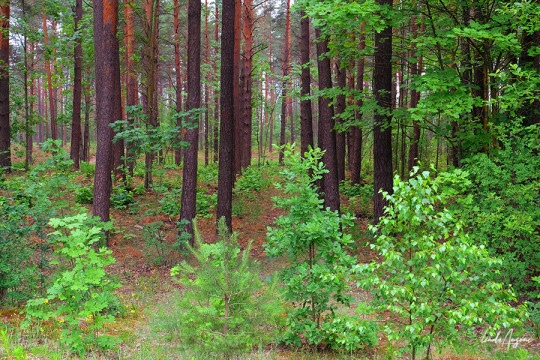

#woods#forest#forest floor#mushrooms#fungi#mushroom photography#mycology#Suillus granulatus#Boletus granulatus#weeping bolete#forestcore#nature#nature photography#original photographers#photographers on tumblr
167 notes
·
View notes
Photo
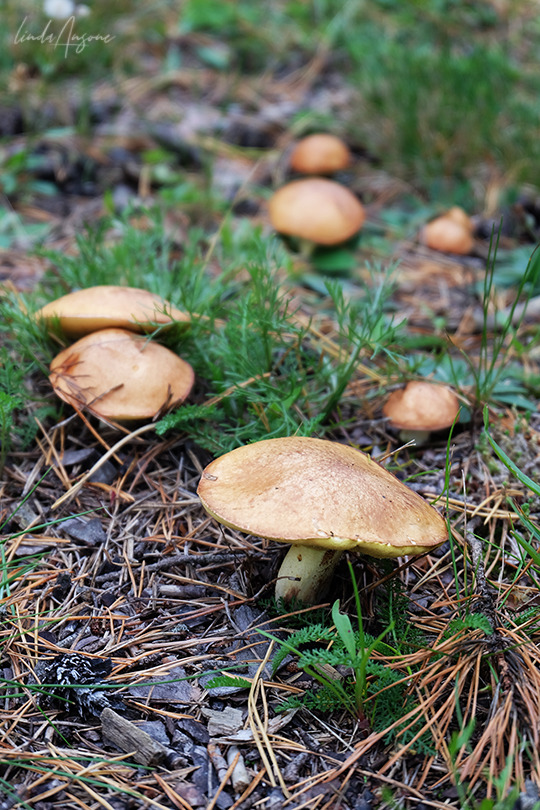
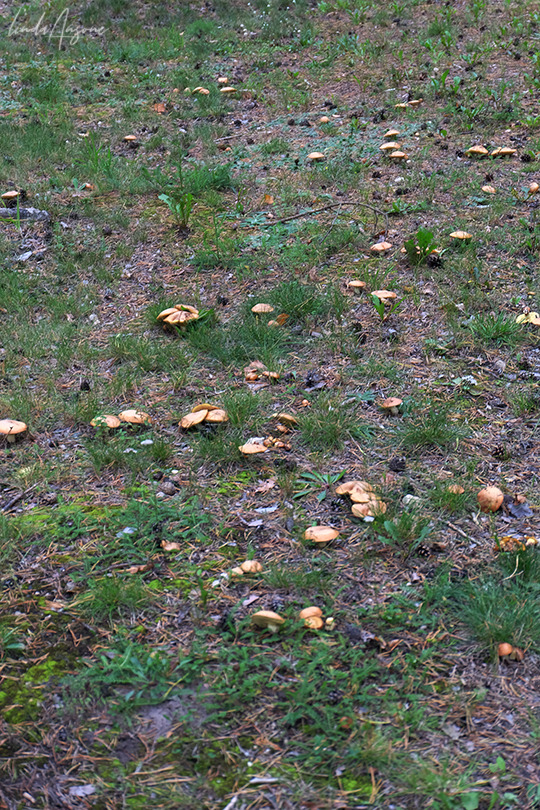
Suillus granulatus tend to grow in large groups.
It is abundant in coniferous forests where it grows under pines, along grassy forest edges and forest tracks, and along grassy edges of scrubby ditches from June to October. (In the photos - along the highway next to forest. However, it is not recommended to collect mushrooms growing near the roads!)
Unfortunately, although edible, it’s most often wormy. Even the smallest individuals can be worm ridden.
This mushroom's cap produces white to yellowish tiny drops of its own juice which stain fingers. The skin of the cap has to be removed before cooking. You can tell it apart from Suillus luteus by the absence of the ring on its stalk.
#mushrooms#fungi#mushroom photography#mycology#Suillus granulatus#boletus granulatus#weeping bolete#dotted-stalk bolete#nature#nature photography#original photography#latvia#original photographers#info
78 notes
·
View notes
Photo

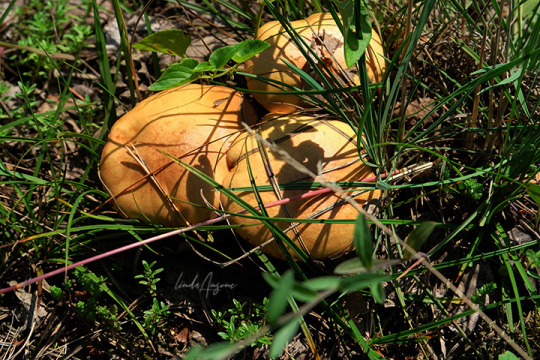
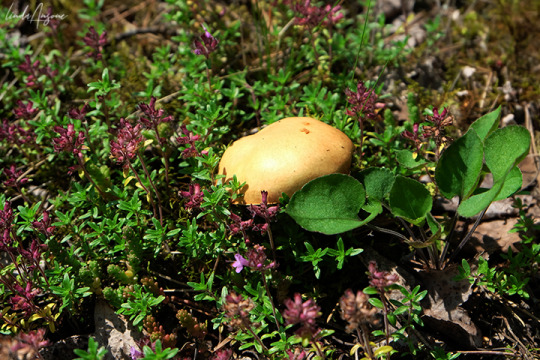
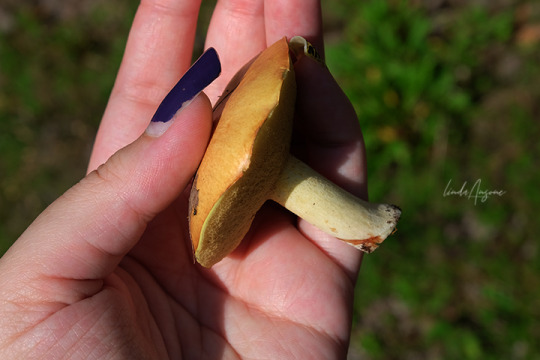
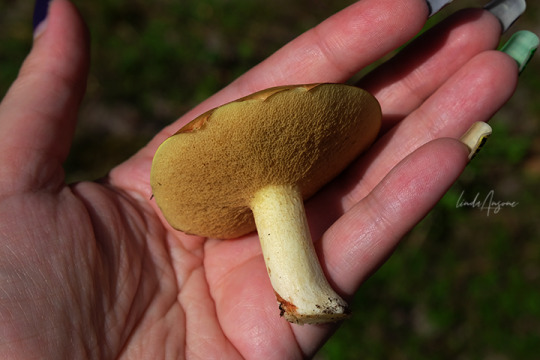
Suillus granulatus | The Weeping Bolete; The dotted-stalk bolete
It is an edible pored mushroom that often grows in a symbiosis with pine. It is similar to the related Suillus luteus, but can be distinguished by its ringless stalk.
S.granulatus has a pleasant fruity scent and a mild taste. Edible and tasty when fried without boiling. One can also pickle and salt it. The peel of its cap should be taken away first.
#mushrooms#fungi#mushroom photography#mycology#bolete#Suillus granulatus#weeping bolete#dotted-stalk bolete#boletus granulatus#nature#original photography#info
103 notes
·
View notes
Photo
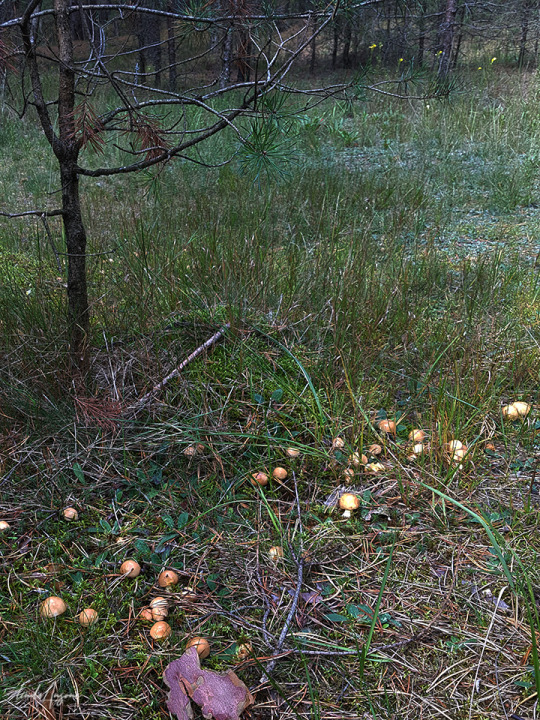


Same like Suillus bovinus, Suillus granulatus can grow in large groups. Both species look a lot alike, except Suillus bovinus normally has a darker stipe. Both granulatus and bovinus species are edible when fried without boiling, but only granulatus is tasty that way. (The peel of its cap should be taken away first.)
#mushrooms#boletes#fungi#Suillus granulatus#weeping bolete#Boletus granulatus#dotted-stalk bolete#original photography#info#there are times I can't tell these two apart#I think some of the species in my woods have mutated lol#not joking
74 notes
·
View notes
Photo


#boletes#boletus#mushrooms#fungi#forest floor#nature#nature photography#mushroom photography#suillus granulatus#weeping bolete#Boletus granulatus#dotted-stalk bolete#original photography#original photographers
125 notes
·
View notes
Photo
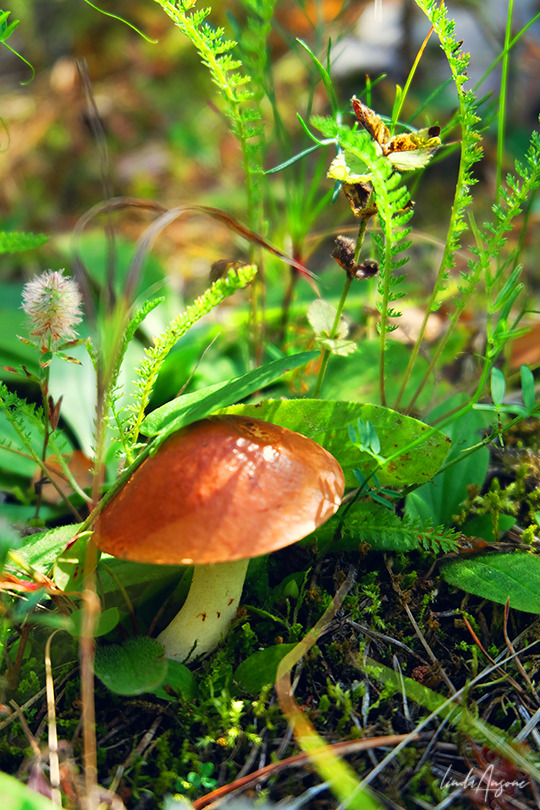
#mushroom#fungus#mushroom photography#bolete#Suillus granulatus#Boletus granulatus#weeping bolete#dotted-stalk bolete#original photography#original photographers#nature#nature photography
66 notes
·
View notes
Photo

#mushroom photography#mushrooms#fungi#bolete#moss#forest floor#Suillus granulatus#Boletus granulatus#weeping bolete#dotted-stalk bolete#mycology#original photographers#photographers on tumblr#nature#nature photography
65 notes
·
View notes
Photo

#mushroom#fungus#mushroom photography#bolete#Suillus granulatus#Boletus granulatus#weeping bolete#dotted-stalk bolete#mycology#nature#nature photography#original photographers#photographers on tumblr
53 notes
·
View notes
